Cheshire West and Chester
Explore hidden histories, historic photos, and things you never knew about Cheshire West and Chester from the collections and archives of Historic England.
Discover your local listed buildings and places
Introducing some of Cheshire West and Chester's most historic sites, included in the National Heritage List for England. Some of these captions have been summarised by AI. Click through for the official List entry. Skip this section and go to place by numbers
Stanlaw Abbey Cistercian monastery and monastic grange, S…
Ellesmere Port
Stanlaw Abbey, founded in the 12th century, transitioned from a Cistercian monastery to a grange linked with Whalley Abbey.
Cathedral Church of Christ and the Blessed Virgin Mary
Chester
The Cathedral Church of Christ and the Blessed Virgin Mary in Chester is significant for its historical associations with figures such as Abbot Richard and Abbot Simon Ripley.
The walls, towers, gates and posterns of the City of Chester
Chester Castle
The walls, towers, gates, and posterns of Chester are part of its oldest designation records, lacking modern descriptions. Contact us for more information.
Eaton Hall
Aldford and Saighton
Eaton Hall's gardens and park include designs by notable figures like John Webb and Edwin Lutyens.
Taylor's Boatyard (including Former Flat Shed, Narrowboat…
Chester
Canal boatyard, mid-C19 with later additions and alterations, built for the Shropshire Union Railways and Canal Company.
Former Verdin Technical Schools & Gymnasium, Northwich
Northwich
Former technical schools and gymnasium, 1896-7, by Joseph Cawley. Ruabon brick laid in English bond with terracotta dressings, slate roof, cast-iron rainwater goods. Mainly 2-storeys.
Pontcysyllte Aqueduct and Canal
St. Martin's
The official listing for all World Heritage sites is held by UNESCO and can be found on their website.
Brunner Mond and ICI Alkali Division War Memorial
Northwich
A First World War memorial of 1921 with alterations after the Second World War, by Darcy Braddell, comprising a Portland stone obelisk and bronze lantern, guarded by four stylised stone...
Mostyn House School
Neston
Former public school, 1855 with 'Old Cottage' of 1881 by A.S. Grenfell and various late C19 and early C20 additions by A.G. Grenfell, also incorporates C18 inn.
Chester Weir and Salmon Leap
Chester
Chester Weir and Salmon Leap, built in 1093 by Hugh Lupus, served St Werburgh's Abbey. It powered major Mills of Dee, and later a 20th-century hydro-electric station.
Beeston Castle; medieval enclosure castle and site of lat…
Beeston
Beeston Castle is a significant medieval enclosure castle offering insights into medieval defense strategies.
Ince Manor monastic grange and fishpond
Ince
Ince Manor is a rare medieval monastic grange in Cheshire, crucial for its historical connection to St Werburgh's Abbey and exceptional preservation.
Castle Park, Frodsham
Frodsham
Castle Park in Frodsham, designed by Edward Kemp, has been a public park since the 1930s, featuring gardens, an Arts Centre, and sports facilities.
Tirley Garth
Utkinton and Cotebrook
Tirley Garth is an early 20th-century garden designed by C E Mallows, with input from Thomas Mawson, accompanying a Neo-Vernacular country house in Cheshire.
Number 37 Street Number 45 Row St Ursulas
Chester
The building features a Grade I listed undercroft dating from the late 12th century, with historical architectural elements and modern alterations.
Old Dee Bridge
Chester
Old Dee Bridge, built in the late 14th century and altered in 1826, spans the River Dee in Chester. It features a distinctive red sandstone construction with seven arches.
The Eastgate and clock
Chester
The Eastgate and clock in Chester, featuring a clock tower by John Douglas, was completed in 1899, financed by Lord Grosvenor and Colonel Edward Evans-Lloyd.
Frandley Quaker Meeting House and Burial Ground Wall
Antrobus
Quaker Meeting House, 1880-1881 in Gothic style, and burial ground wall, C17. Read the official list entry to find out more.
Ness Botanic Gardens
Neston
Ness Botanic Gardens were developed by Arthur Kilpin Bulley for plant collection, later donated to the University of Liverpool, focusing on diverse horticultural research and themes.
Number 48 and 50 Street Numbers 48, 50 and 52 Row Three O…
Chester
Number 48 and 50 Street/Row have historical significance as part of Chester's architecture.
Number 17 Street Number 21 Row Leche House
Chester
Leche House, a historic Chester landmark, showcases late 14th-century undercroft, ornate timber framing, and intricate plasterwork. Once the Leche family's home, it now houses shops.
Number 11 Street Numbers 15 and 15A Row the Old Crypt
Chester
No.11 Street and Nos.15 & 15A Row, known as The Old Crypt, feature medieval and Georgian architecture, with significant undercroft dating to circa 1300.
Roman Shrine to Minerva
Chester
The Roman shrine to Minerva in Edgar's Field, carved in the early 2nd century from red sandstone, is the only in situ example of its kind in Britain.
Church of St Paul, including south-west boundary wall and…
Ellesmere Port
Anglican church, 1858-62, by James Kellaway Colling. Rock-faced local red sandstone with Stourton ashlar, red sandstone ashlar dressings and slate roofs.
Bear and Billet Public House
Chester
The Bear and Billet Public House, built in 1664 for the Earl of Shrewsbury, is an architecturally significant timber-framed building in Chester, now serving as a public house.
Seven Steps, Butchers Shop and Teal Cottage
Neston
Built before 1732 for the Mostyn Estate, Seven Steps, Butchers Shop, and Teal Cottage served passengers at Parkgate port. Notable for Dutch-style wall paintings.
Brunner Mond Lostock Gralam (Northwich) War Memorial
Northwich
First World War memorial of 1921 with Second World War additions, by Darcy Braddell for Brunner Mond. Read the official list entry to find out more.
Marton moated monastic grange, three fishponds, connectin…
Whitegate and Marton
Marton moated monastic grange, once part of Vale Royal Abbey, features well-preserved archaeological remains, including fishponds and structures from the Tudor manor house era.
Tarporley War Memorial
Tarporley
First World War memorial and dedication tablet by Sir Percy Scott Worthington. Read the official list entry to find out more.
Christleton War Memorial
Christleton
First World War memorial unveiled on 25 April 1920, with later additions for the Second World War. Read the official list entry to find out more.
Neston War Memorial
Neston
First World War memorial cross, unveiled 1920, with later additions for the Second World War. Read the official list entry to find out more.
Helsby Junction Signal Box
Helsby
London North Western Railway Type 4 signal box built 1900. Read the official list entry to find out more.
South East Angle Tower and Wall of Roman Legionary Fortress
Chester
Summary of the 1st-century to 2nd-century Roman Legionary Fortress, known for its purple-grey ashlar sandstone base and remaining foundation structures in Chester.
St Marys Centre
Chester
St Mary's Centre in Chester is a historic parish church turned educational center, featuring notable stained glass, monuments, and a rich architectural history from the 14th century onward.
13 and 15 Watergate Street and 17 and 19 Watergate Row South
Chester
A pair of medieval shops and town houses with open stalls at Row-level, over undercrofts at Street-level, re-built and altered during the C18, C19 and C20.
Spur Wall and Water Tower
Chester
The Spur Wall and Water Tower in Chester, built by John Helpstone between 1322-6, features medieval crenellation and was crucial for commanding the medieval port.
Number 10 Row Cowper House Number 12 Street
Chester
Number 12 Bridge Street and 10 Bridge Street Row West features a mid-17th-century timber-framed townhouse atop an early-13th-century stone undercroft linked with Thomas Cowper.
Church of St Peter
Chester
The Church of St Peter is historically significant, founded in 907AD by Aethelfled on a Roman site. It underwent various restorations from the 14th to 19th centuries.
Explore more
Search for more listed placesCheshire West and Chester through time
This timeline shows the first period of use for buildings and places on the National Heritage List for England, just one of the details recorded for every list entry. Click around to see how Cheshire West and Chester changes over time. Skip this section and go to aerial photos
Prehistoric Before AD 43
Prehistory covers a million years of human occupation before the Roman invasion and the introduction of writing. Primarily hunter-gatherers of several human species including Neanderthals, the peoples moved across Europe, hunting animals, exchanging ideas and developing complex culture and belief systems including burial rites and astronomical understanding, as at Stonehenge for example.
Roman AD 43 to AD 410
Britain was invaded by four legions of the Roman army in AD 43, who relatively rapidly conquered England from landing points in Kent. Parts of Wales and Scotland soon followed.
Roman culture brought urbanism, monumental buildings, wide-ranging religious beliefs, writing, and strong social hierarchy. The Roman administrative system was withdrawn in AD 410.
Early medieval AD 410 to AD 1066
This period, often associated in England with Anglo-Saxons and Vikings, saw a reduction in urban living from the Roman period and increased migration from northern Europe.
Traces of this period can be found in cemeteries, particularly in artefacts and in some of the very early churches, as this period also saw the growth of Christianity in Britain.
Medieval AD 1066 to AD 1540
This period, sometimes known as the Middle Ages, began with the Norman invasion in AD 1066. It saw a significant rise in military and defensive buildings such as castles and earthworks, as well as religious houses dominating a largely agricultural landscape.
The monarchy and Church dominated the period, which also saw the break with the Roman Catholic Church and the English reformation.
Post medieval AD 1540 to AD 1901
The Post-Medieval period brought seismic changes to life in England, with religious reformation leading to the democratization of worship and the destruction of hundreds of religious houses.
In parallel, there was a huge expansion of scientific study and enlightenment that permanently altered the nation's social structure and landscape. Industrialization and mass production lead to wider global trade, emigration, and immigration.
20th century AD 1901 to AD 2000
The 20th century saw an incredible expansion of England's transport networks, with suburban growth shadowing rapid infrastructural expansion. The establishment of state schools, hospitals, and modern technical colleges, with new architectural styles, radically changed the appearance of towns and cities.
Two catastrophic world wars and the 1918 pandemic also brought unprecedented change, altering England's built environment and social structures forever.
Prehistoric Before AD 43
Prehistory covers a million years of human occupation before the Roman invasion and the introduction of writing. Primarily hunter-gatherers of several human species including Neanderthals, the peoples moved across Europe, hunting animals, exchanging ideas and developing complex culture and belief systems including burial rites and astronomical understanding, as at Stonehenge for example.
Roman AD 43 to AD 410
Britain was invaded by four legions of the Roman army in AD 43, who relatively rapidly conquered England from landing points in Kent. Parts of Wales and Scotland soon followed.
Roman culture brought urbanism, monumental buildings, wide-ranging religious beliefs, writing, and strong social hierarchy. The Roman administrative system was withdrawn in AD 410.
Early medieval AD 410 to AD 1066
This period, often associated in England with Anglo-Saxons and Vikings, saw a reduction in urban living from the Roman period and increased migration from northern Europe.
Traces of this period can be found in cemeteries, particularly in artefacts and in some of the very early churches, as this period also saw the growth of Christianity in Britain.
Medieval AD 1066 to AD 1540
This period, sometimes known as the Middle Ages, began with the Norman invasion in AD 1066. It saw a significant rise in military and defensive buildings such as castles and earthworks, as well as religious houses dominating a largely agricultural landscape.
The monarchy and Church dominated the period, which also saw the break with the Roman Catholic Church and the English reformation.
Post medieval AD 1540 to AD 1901
The Post-Medieval period brought seismic changes to life in England, with religious reformation leading to the democratization of worship and the destruction of hundreds of religious houses.
In parallel, there was a huge expansion of scientific study and enlightenment that permanently altered the nation's social structure and landscape. Industrialization and mass production lead to wider global trade, emigration, and immigration.
20th century AD 1901 to AD 2000
The 20th century saw an incredible expansion of England's transport networks, with suburban growth shadowing rapid infrastructural expansion. The establishment of state schools, hospitals, and modern technical colleges, with new architectural styles, radically changed the appearance of towns and cities.
Two catastrophic world wars and the 1918 pandemic also brought unprecedented change, altering England's built environment and social structures forever.
Aerial photos of Cheshire West and Chester
Aerial photography helps reveal secrets of England's changing landscapes that are impossible to see from the ground. Skip this section and go to archive images

Beeston
Beeston Castle, Beeston, 1927

Beeston
Beeston Castle, Beeston, 1948
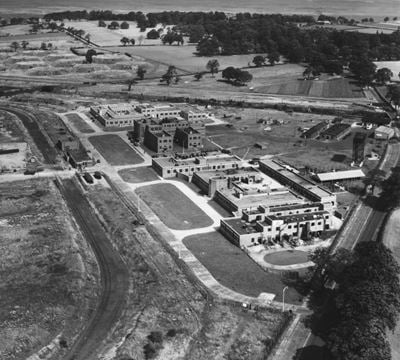
Stanlow
The Thornton Research Centre, Stanlow, 1947
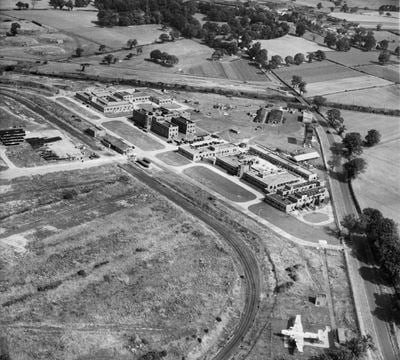
Stanlow
The Thornton Research Centre, Stanlow, 1947

Tilstone Fearnall
Tilstone Lodge and gardens, Tilstone Fearnall, 1947

Tilstone Fearnall
Tilstone Lodge and gardens, Tilstone Fearnall, 1947
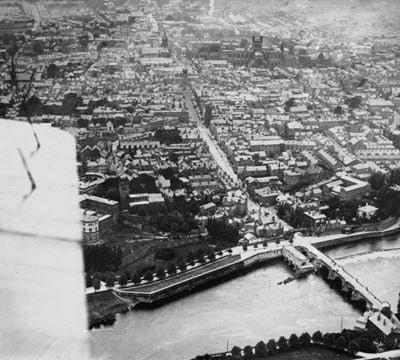
Chester
Lower Bridge Street and environs, Chester, 1920
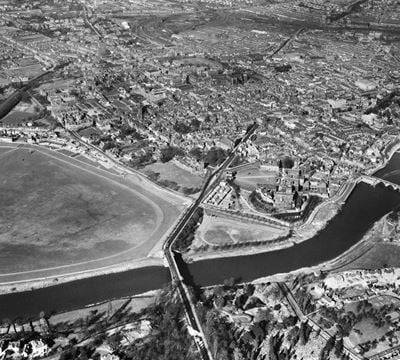
Chester
Chester Castle and the city centre, Chester, 1948
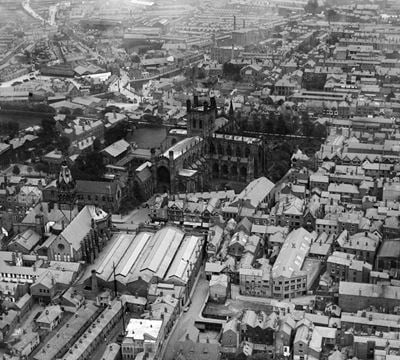
Chester
The Cathedral Church of Christ and the Blessed Virgin Mary, Chester, 1920
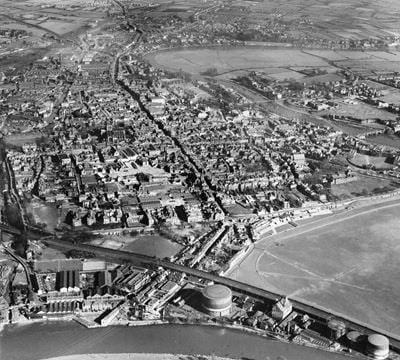
Chester
The city centre, Chester, 1948
Cheshire West and Chester in the Historic England Archive
The Historic England Archive cares for over 15 million images, dating from the 1850s to the present day. Discover stunning images of Cheshire West and Chester's past. Skip this section and go to stories about heritage
Charles George Harper Collection
Chester, Cheshire West And Chester
Date created: 1892 - 1933
The base and shaft of the cross known as the Roodeye Cross
Eileen ‘Dusty’ Deste Collection
Chester, Cheshire West And Chester
Date created: 1965 - 1968
A view looking across the Shropshire Union Canal towards the King Charles Tower, aka Phoenix Tower, on the Chester City Walls
Eric de Mare
Chester, Cheshire West And Chester
Date created: 1945 - 1980
General perspective view of the Old Dee bridge in Chester. It was built in 1387 on the site of previous wooden bridges and an old Roman fording site.
John Gay Collection: Counties
Malpas, Cheshire West And Chester
Date created: 22 DEC 1953 - 07 JAN 1954
A view from within the stone porch of St Oswald's Church, looking out through ther pointed arch and wrought-iron gates towards the churchyard, with a...
John Laing Collection
Stanlow, Ellesmere Port, Cheshire West And Chester
Date created: Oct 1953
An interior view of part of Stanlow Oil Refinery during its construction
London, Midland and Scottish Railway Company
Cheshire West And Chester
Date created: 29 Aug 1933
A view looking across the forecourt of Eaton Hall towards the chapel and west front of the house, with the statue of the 1st Earl of Chester in the...
Nigel Temple Collection of Postcards of Parks and Gardens
Cheshire West And Chester
Date created: 1904 - 1909
POSTCARD SHOWING THREE VIEWS WITHIN THE PARK
Walter Scott
Cheshire West And Chester
Date created: 1925 - 1935
A view of the country house from the east, with the axial canal and a statue in the foreground
John Gay Collection: Counties
Cheshire West And Chester
Date created: Jan 1953
A distant view towards Beeston Castle and Crag
London, Midland and Scottish Railway Company
Cheshire West And Chester
Date created: 29 Aug 1933
A view looking along the ornamental canal towards the east elevation of Eaton Hall
Nigel Temple Collection of Postcards of Parks and Gardens
Cheshire West And Chester
Date created: 1900 - 1909
GENERAL VIEW
Walter Scott
Cheshire West And Chester
Date created: 1925 - 1935
A view of the country house from the east, with the Fish Pond in the foreground
Stories about heritage in your local area
Historic England publishes news, blogs, research, videos, and podcasts celebrating England's rich heritage. Discover the stories we have about Cheshire West and Chester. Skip this section and go to education
The Legend of King Arthur
Mentions Remains of Roman Amphitheatre
King Arthur was central to the legendary tales of medieval romance. Discover the places connected to Camelot, Tintagel, and the Battle of Badon Hill.
5 Things to Know About Coronations
Mentions Coronation Lamp Post and Lantern
Discover the history and heritage behind the ancient English coronation ceremony.
Gruesome Georgians: Crime and Punishment
Mentions Stocks
Discover some of the buildings and listed places connected to the underworld of Georgian England
6 Historic Sites Added to the Heritage at Risk Register
Mentions Propylaea
Our Heritage at Risk Register is an annual snapshot of the health of England’s heritage.
Five Metal Detectorists Sentenced in Biggest Operation of its Type
Mentions Cheshire West and Chester
A Tameside nighthawking gang has been sentenced after admitting unlawful metal detecting at Beeston Castle, Cheshire and Roche Abbey, South Yorkshire.
Funding Secured for Historic High Streets Recovery
Mentions Cheshire West and Chester
High Streets across England given the green light for Historic England regeneration schemes to aid their economic recovery.
War Memorials Built 100 Years Ago Listed to Commemorate the First World War on Armistice Day
Mentions Burton in Wirral Peace Cross, Winsford War Memorial
These war memorials and shrines became a precursor what was to come: the national movement to memorialise that took place following the war.
Cheshire West and Chester's social history through photos
Over 10,000 images from the Historic England Archive have been specially selected and re-captioned for teachers, students, and anyone who wants to learn more about their local area. Skip this section and go to grant-aided places
Workshop (formerly a barn) at Barnhill Grange, Broxton, Cheshire
Period: Georgian (1714 - 1836)
This rather grand looking building was originally a barn and shippon. Shippon is another word for a cowshed. It was built in the early 19th century.
Workshop (formerly a barn) at Barnhill Grange, Broxton, Cheshire
Tags
Willaston Mill, Neston, Cheshire
Period: Georgian (1714 - 1836)
This windmill was built in 1805. In 1962 the windmill was converted into a dwelling, which still remains.
Willaston Mill, Neston, Cheshire
Weaver Hall, Northwich, Cheshire
Period: Victorian (1837 - 1901)
This building was originally the Northwich Union Workhouse. It was built in 1837-9 by George Latham, using the '200 pauper' model.
Weaver Hall, Northwich, Cheshire
Tags
Watergate Street, Chester, Cheshire
Period: Stuart (1603 - 1713)
View along Watergate Street.
Watergate Street, Chester, Cheshire
Watergate Row, Watergate Street, Chester, Cheshire
Period: Victorian (1837 - 1901)
General view along Watergate Row
War Memorial, Moulton, Cheshire
Period: 1920s (1920 - 1929)
This monument commemorates the British soldiers who died in the First World War.
War Memorial, Moulton, Cheshire
Vine Cottage and Smithy Cottage, Aldford, Cheshire
Period: Victorian (1837 - 1901)
These cottages were built in 1863, for the 2nd Marquis of Westminster, Richard Grosvenor.
Vine Cottage and Smithy Cottage, Aldford, Cheshire
Vale Royal Abbey, Whitegate, Vale Royal, Cheshire
Period: Medieval (Middle Ages) (1066 - 1484)
This grand country house stands on the site of a former Cistercian abbey.


